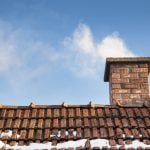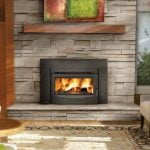How the Cold Can Affect Your Chimney This Winter
Many homeowners want a fireplace in their homes and one of the main reasons to have one especially during the winter is to help heat your home throughout the season. Fireplaces are designed to keep you warm however, the cold temperatures can have a negative impact on your chimney.
The ice, snow, and drastic changes in temperatures this season have the potential to cause damage to your chimney or add on to damage that has already occurred. You can only tolerate the dreaded polar vortex for so long before the mid-winter blues and the negatives of how this weather can affect your home instead of watching it fall.
To ensure you are taking the precautions and doing everything you can to prevent any further damage, here are ways the cold can negatively affect your chimney.
The Stack Effect
For those of you who are not aware, the stack effect is the movement of air into and out of buildings, chimneys, flue-gas stacks, or other containers, resulting from air buoyancy. The stack impact can will cause smoke to back-draft into your home. once the temperature outside is considerably colder than the air temperature within, the cooler outside air can rush down the chimney shaft to interchange the rising warm air.
These back-drafts may be prevented if the damper is kept closed if you are not using the fireplace. Additionally, warming the flue could intercept smoke from blowing back into the space directly once a fireplace is lit. To heat the flue, light a small quantity of kindling and hold it beneath the opened damper for a few minutes before lighting the remainder of the fire. If you do this moderately, it will warm the air within the flue which can prevent a rush of cold air from flooding down the chimney if a fire is lit.
Have You Checked Your Vents?
During the winter season, we advise you to make sure your chimneys and vents as well as gas appliances must be cleared of any snow or ice to have proper venting and avoid any carbon monoxide accumulation within your home, as both are very dangerous for your home and residents. As a result of a potential issue being prolonged, symptoms of low-level carbon monoxide poisoning include the following: headaches, nausea, dizziness fatigue, damage to the brain, heart and other organs have occurred.
Animal Entry
With the polar vortex temperatures, many individuals have wanted to stay indoors to avoid embracing the chilling temperatures outside. However, animals have the same mindset and do the same. Animals such as raccoons and squirrels often look to chimneys as shelter during the winter and you may not even know they are there. If you have found that there are animals entering your chimney, we suggest calling a professional to have them safely removed. We strongly advice you to remove the animals yourself due to different diseases the animal may have or start a fire while the animal is in the chimney. This could cause smoke and carbon dioxide build up in your house if the chimney is closed and there is no way for the smoke to release.
After the animals are removed, it’s necessary to hire a licensed chimney sweep to inspect your chimney. These professionals can make the necessary masonry repairs in order to stop animals from returning in addition to removing any blockages left behind within the chimney to avoid any damage to the flue linking or gas and smoke to back up in your house. Certified chimney sweeps will examine your chimney and will give you the answers you need to have an enjoyable winter season indoors without any worry or hesitation.
Masonry Chimney Damage
The weather throughout the season can be particularly damaging to your home’s chimney because of moisture build up and major temperature fluctuations. Moisture damage may not be a noticeable issue right away but will result in homeowners finding damage to the masonry, chimney crown, and/or the chimney liner.
During the winter season, in order to prevent winter masonry damage, we suggest protecting your chimney from water and moisture as a number one priority. In order to do so, you can start by making sure your chimney cap is in place and in good shape. A chimney cap helps prevent water from running down your chimney flue and causing damage. Another thing to note is your chimney’s crown deflects water away from the chimney flue and should provide some protection to the exterior sides of your chimney. During an annual inspection with a licensed professional, confirm that your chimney crown has been properly assembled and free from any harm or future damage.
Snow Damage
Snow harm to masonry chimneys is sometimes a slow, refined process. the issues it could cause are typically not evident until they’ve become quite serious and worsened. Due to the severity of potential problems to your chimney, you want to make sure you seek out a licensed professional who you can trust to take care of the issue and move forward with a strong chimney with no further issues.
Water Damage
The main reason for your chimney to deteriorate throughout the winter is due to water damage. Any bricks on your chimney that are cracked or broken will absorb water from precipitation then freeze if the temperature drastically drops. Cold weather can result in damage to your chimney’s masonry and once water becomes trapped inside, the moisture will freeze and expand. When the water starts to melt, that only exceeds the amount of water entering the brick. This causes your chimney’s masonry to crack and crumble as a result.
Most masonry materials can absorb massive amounts of water. Common brick is similar to a sponge by absorbing water and wicking moisture to your chimney’s interior. Defective mortar joints or the utilizing improper mortar or brick can increase the tendency to soak up and convey water to the inside of the masonry chimney structure. Another thing to note is when water mixes with the creosote that’s usually in a wood-burning home, it will most likely generate an odor that may disperse throughout the home. These factors all have the capability of compromising the structure of the chimney. We suggest acting upon any of these issues as soon as possible if you are experiencing them in your home. The sooner the better to prevent further water damage to the chimney flue, or other fireplace parts.
Summary
Wisconsin winters can be harsh not only on your, but for your chimney. Ice, snow and sleet and frigid temperatures can be a damaging factor to your chimney especially during this time of the year so we want you to be properly informed of the signs of damage and what to do in order to stay on top of any necessary repairs right away.
If winter’s cold weather has been hard on your chimney’s masonry, contact us at United Brick & Fireplace. We can evaluate wintertime chimney damage and restore your chimney.
ABOUT UNITED BRICK AND FIREPLACE
Our family-owned business has been serving the Madison community since 1973 for fireplaces, brick, block, stoves, and outdoor stone needs. We work with homeowners, builders, architects, masons, and general contractors to supply the best products in each industry. As the largest fireplace installer in Madison, we have the expertise and product offering for nearly every situation including unique architectural designs for homes and commercial settings. Contact us for more information or visit one of our showrooms today!




